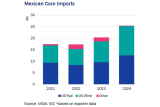
Over the last five years Colombian coal exports have suffered from a pandemic, political instability and extreme weather. Colombia exported 76.4 Mt of coal in 2019 and just 52.1 Mt in 2020. The country has struggled to recover to pre-pandemic levels and exports have remained in the 50s ever since. Whilst 2024 annual export figures showed some encouraging signs, at 57.5 Mt, up 2.0% y-o-y and the highest annual number since the sharp drop, the annual total belies a more recent decline, with many familiar problems.
In fact all of the growth in 2024 came in the first half of the year. Colombian coal exports in 1H 24, averaged 5.1 Mt per month up 15% y-o-y. Even the growth in the first half of the year was front-loaded; Q1 exports grew 22% yo-y, slowing to 8% y-o-y in Q2. March was the strongest month since February 2020 at 6.7 Mt. The second half of the year told a completely different story, Q3 exports fell 5% y-o-y and Q4 exports fell 14% y-o-y to 13.1 Mt (the lowest Q4 figure since 9.5 Mt in 2020). This decline seems to have continued into 2025, with January exports down 30% y-o-y at 3.1 Mt.
As with the decline in 2020, a key contributory factor to the decline seems to have been politics. Guerilla fighting in the country has ramped up significantly this year, with the president calling an end to peace talks with the ELN group following their killing of demobilised FARC members (a rebel group that have largely agreed to peace deals). In a separate incident, unlikely to be connected to ELN, railway infrastructure at Glencore’s Cerrejón mine (which before Glencore took over in 2022 and reduced production, used to be the largest coal mine in Colombia) was bombed on 6th January for the second time in 15 days. The mine and related infrastructure has regularly been targeted by local groups, but reports suggest a worrying rise in frequency.

The government are also facing difficulties in tackling fiscal problems, with their budget deficit reaching 6.8% of GDP in 2024. Fitch ratings agency have recently downgraded Colombia’s rating outlook to negative from stable, with a dismal view of their ability to get the budget balanced. Fiscal concerns have had a direct impact on coal mining as the government imposed a 1% tax on all fossil fuel production – the Colombian Mining Association (ACM) points out that the country already faces some of the highest taxes in the world.
All of the domestic problems, particularly the increase in taxes, damage the competitiveness of Colombian coal in the global market, and Colombian miners are facing displacement with some key import partners. Of the 2.1 Mt y-o-y drop in Q4 exports from Colombia, exports to the Far East dropped by 693kt, and exports to the Mediterranean/Black Sea region fell by 1.4 Mt.
The largest chunk of the drop in the Far East came from a 804kt drop in exports to China. The burst in activity that drove strong Capesize tonne-mile demand right into mid 2024 came to a very abrupt end. Exports peaked at 1.5 Mt in March, but in Q4 averaged just 55kt per month. At the same time Chinese imports of Mongolian bituminous coal have climbed from 1.1 Mt per month in Q4 23 to 2.0 Mt per month in Q4 24.
In the Med/Black Sea there had been a sharp decline in Israeli imports following a ban in response to the Gaza conflict (down 576kt y-o-y in Q4 24), and also in Turkey (down 622kt y-o-y). The decline in Colombia-Turkey trade has been a longer term trend, with Russia picking up the slack as can be seen in the chart to the left.
The long-term decline in European demand had lead to an uptick in laden distances for Colombian exports as volumes were directed elsewhere, and distances remain
above pre-2023 levels. However, the recent decline in shipments to the Far East and to Med/Black Sea have dragged laden distances down from their peak of around 9,800nm in Q2 24 to 6,400nm in Q4 24.
By William Tooth, Senior Dry Bulk Analyst, Research, SSY.
Articles
You may also be
interested in
View allGet in touch
Contact us today to find out how our expert team can support your business












